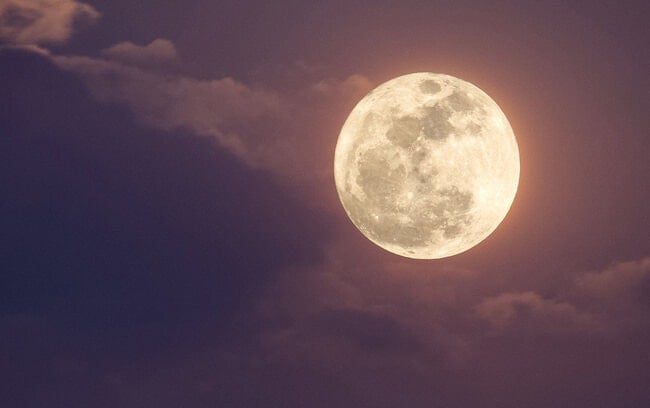When Is The Next Supermoon 2025?

There will be three full Moon Supermoons in 2025: October 6 (Harvest Moon), November 5 (Beaver Moon), and December 4 (Cold Moon). See all full Moon dates, times, and names.
What Is A Supermoon?
Supermoons are caused by the shape of the Moon’s orbit, which is an ellipse (not a perfect circle). Each month, the Moon reaches its farthest point from the Earth (apogee) and closest point (perigee).
A “supermoon” occurs when the Moon is at least 90% of the way to its perigee position at the same time that it is in its “full” or “new” phase. If either of these phases occurs when the Moon happens to be exactly at perigee, the Moon is considered to be an “extreme perigean supermoon.”
Why New And Full Phases?
The reason these two phases are singled out is because each of them means that the Sun, Earth, and Moon are in alignment. When the Moon is full, it sits exactly on the opposite side of the Earth from the Sun. When the Moon is new, it sits between the Earth and the Sun. In both cases, the gravitational pull from these two bodies—the Moon and the Sun—combine to create higher-than-normal tides, called “spring tides,” on Earth. When the Moon is also at perigee at this time, the effect is magnified into what is called a “proxigean spring tide.”
Full Moons get all of the attention around Supermoons because they reflect the Sun’s light. Supermoons during a new phase on the other hand are invisible to the naked eye. In 2025, the New Moon Supermoons fall on the following dates: October 21, November 20, and December 19.
Fun fact: On Saturday, January 21, 2023, the New Moon was at its closest distance to Earth in nearly 1,000 years (992 to be exact).
What’s In A Name?
The term “supermoon” became popular in March 2011 when the Moon’s perigee brought it to 221,565 miles of Earth—within 127 miles of the absolute closest that it can come (the absolute closest the Moon can come is 221,438 miles from Earth—an exceedingly rare occurrence).
In actuality, the designation should only be applied to “extreme” perigees, in which the full Moon approaches a distance of 221,472 miles or less. Between the years A.D. 1500 to 2500, this condition is met only 14 times, or on average once about every 71 years. The last time the full Moon came this close to Earth was January 15, 1930 (221,454 miles) and the next time will be on December 6, 2052 (221,469 miles).
But if you follow the 90% rule noted above, you can have as many as three—and on some occasions even four or five—supermoons in a single year!
Not All Supermoons Are Created Equal!
Just as the Moon’s orbit isn’t a perfect circle, it also varies slightly from month to month and year to year. Its perigee during one month may be slightly farther from the Earth than its perigee the next month.
Many people speculating that extreme supermoons can cause natural disasters such as earthquakes, volcanoes, and tsunamis. But most astronomers dismiss this line of thinking, though, arguing that the 2,000-mile difference (less than 1% of the Moon’s total distance from Earth) is minimal in the grand scheme of things and unlikely to cause much disruption on Earth, beyond the usual perigean spring tide.
Regardless of what you believe about a Supermoon’s impact on Earth, or what you call it, one thing is certain: If the sky is clear, the view of the rising Moon will always be amazing, so get outside and enjoy it!
Join The Discussion
What is your favorite phase of the Moon?
How do you plan to celebrate the next supermoon 2025?
Share with your community here in the comments below!
Related Articles
How To Set Goals With The Moon
















The supermoon may look especially large to you, however, if it’s very close to the horizon. But that has nothing to do with astronomy and everything to do with how the human brain works. This effect is called the “moon illusion” and may arise from at least a couple of different things. Scientists suggest that perhaps the brain is comparing the moon to nearby buildings or objects, or perhaps our brain is just wired to process things on the horizon as bigger than things in the sky.
I haven’t seen any thing kind of like that here in alabama lmao 🙂
I saw it okay last night in Australia. Very bright, couldn’t see any significant difference in size.
Awesome Moon,which I enjoy.It appeared brighter,not bigger,here in Maine.I saw it & took pics,which I posted.Thanks,I follow the Moons dates,names,& meanings!
Will we get the same effect here on the other side of the Earth? I’ll certainly be looking out for it anyway. Thanks for that info.
guess i miss supermoons in the pass i’ll see this one i hope!
does it have effect on the weather?
Ray, That’s controversial, but most meterologists say “no.” It will have an effect on the tides, though, making them higher than normal.
We have an “AWESOME” God and he sends us beautiful presents to enjoy. Hope we can see the moon in Indiana…waiting.
In 2011 God was tolerating us. 2019-2020…let’s just say it’s time we get some punishment for our bad behavior. God is some kind of pissed off at the moment
very kool just what i needed to brighten up this long cold winter thanks.
If you only knew then what you know now lol. Who would of EVER thought the entire world would be hiding from or quarantined from the COVID-19 global pandemic. I’ll see it on Tuesday, from the safety of a wide open field
Everyday there are awesome wonders of God. Some days are more AWESOMER 🙂
Thanks for posting this article for me Jaime!